PR
X
Keyword Search
▼キーワード検索
Comments
2025年版・岡山大学…
 New!
隠居人はせじぃさん
New!
隠居人はせじぃさん
続日本100名城東北の… New! オジン0523さん
【甥のステント挿入… New!
Gママさん
New!
Gママさん
ムベの実を開くコツ… noahnoahnoahさん
noahnoahnoahさん
エコハウスにようこそ ecologicianさん
 New!
隠居人はせじぃさん
New!
隠居人はせじぃさん続日本100名城東北の… New! オジン0523さん
【甥のステント挿入…
 New!
Gママさん
New!
Gママさんムベの実を開くコツ…
 noahnoahnoahさん
noahnoahnoahさんエコハウスにようこそ ecologicianさん
Calendar
カテゴリ: 海外旅行
さらにリフィー川に沿って歩き Loopline Bridge
を潜ると左前方に現れたのが、
Custom House Visitor Centre・歴史博物館。
アイルランド政府によって整備された公共の歴史展示施設で、アイルランドの近代史と
カスタム・ハウス自体の歴史を中心に紹介していた。


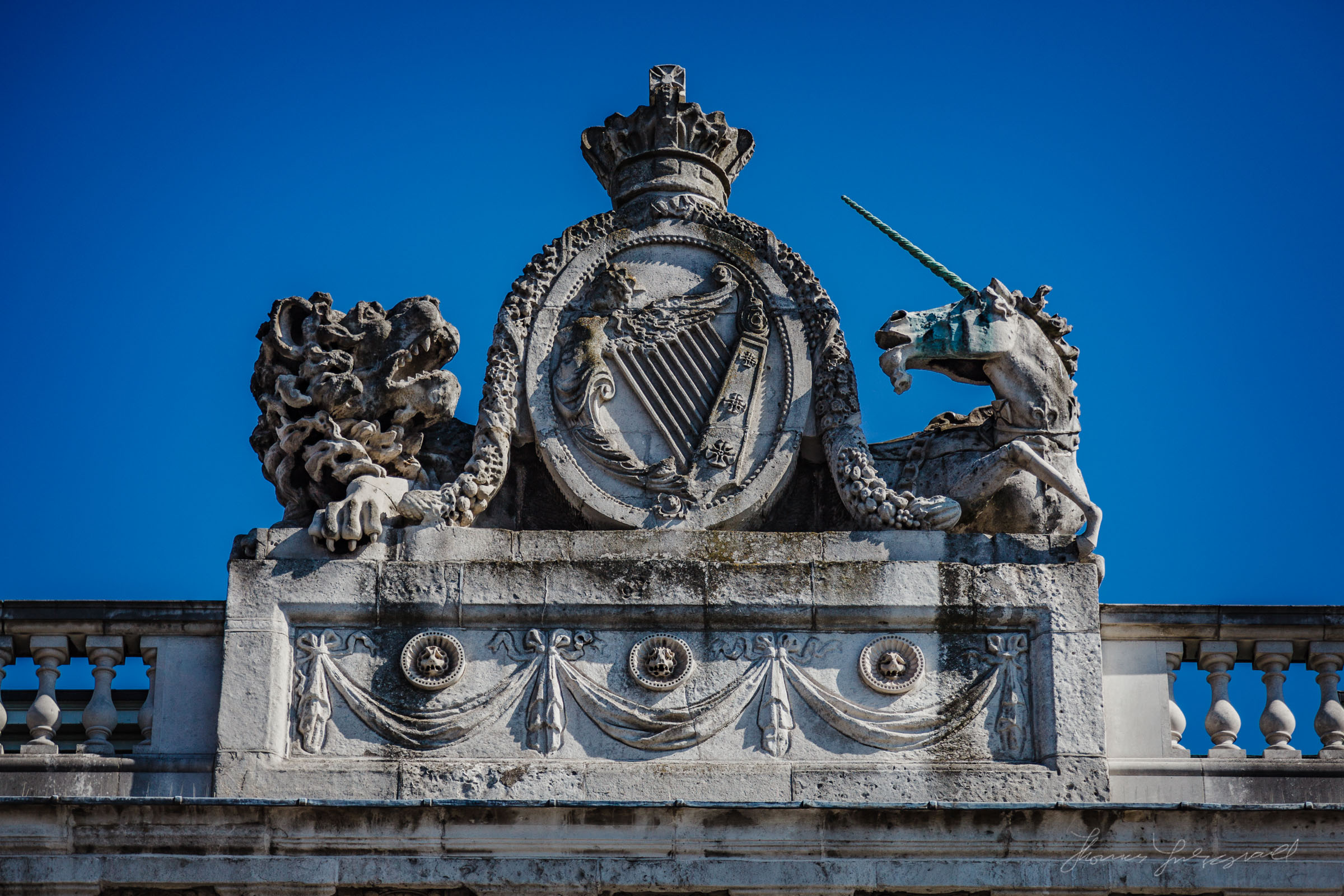
下記写真はネットから。
正面ファサードの特徴
1. 中央ドーム:
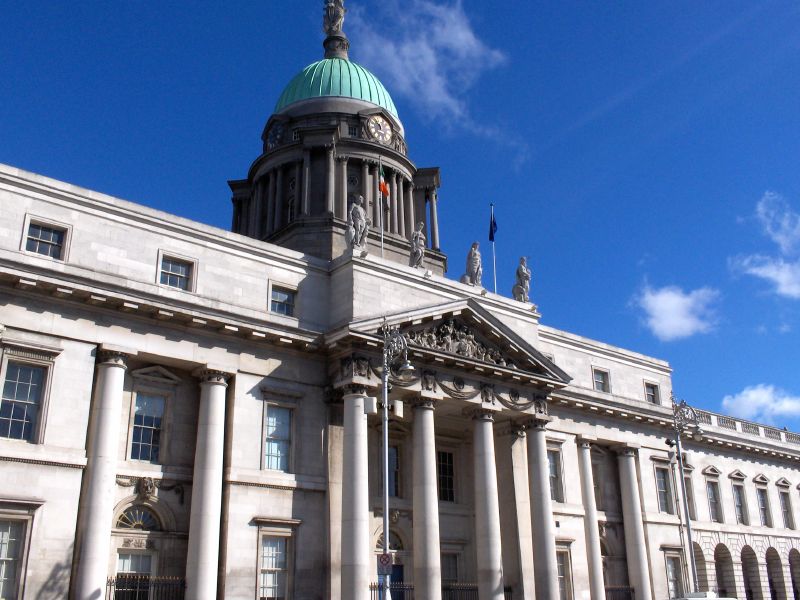
頂上に立つ 「Commerce(商業)」 の女神像を見上げて。
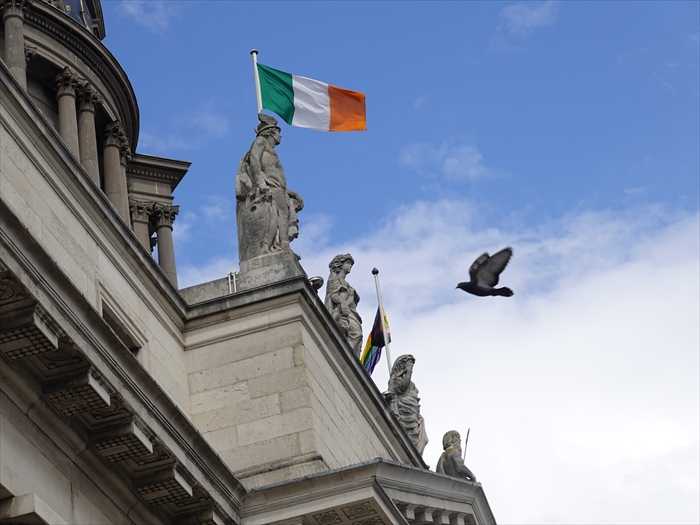
正面から。(ネットから)
左から 順に

カスタム・ハウス(The Custom House, Dublin)の ドームを斜めに見上げて
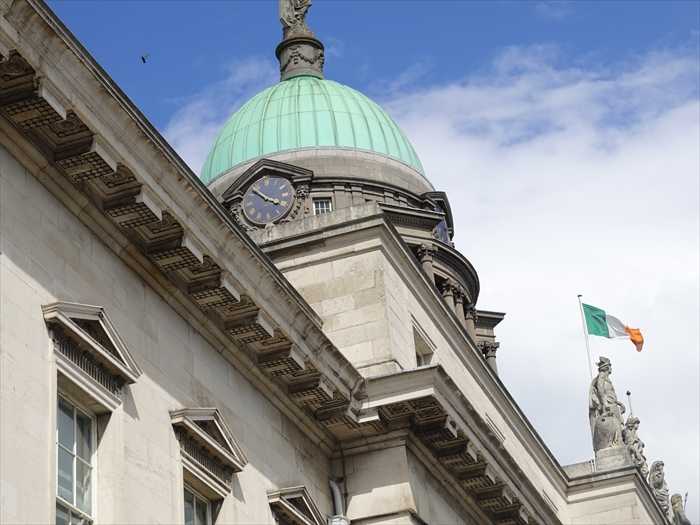
カスタム・ハウス(The Custom House, Dublin) の 中央正面入口(ポーチ部) を見上げて。
巨大なコリント式円柱 ・正面入口は2本の巨大な円柱に支えられたポルティコ(列柱玄関)に
包まれています。
・柱頭はこの角度では見えないが、通常この建物ではコリント式(花飾り付き)を採用。
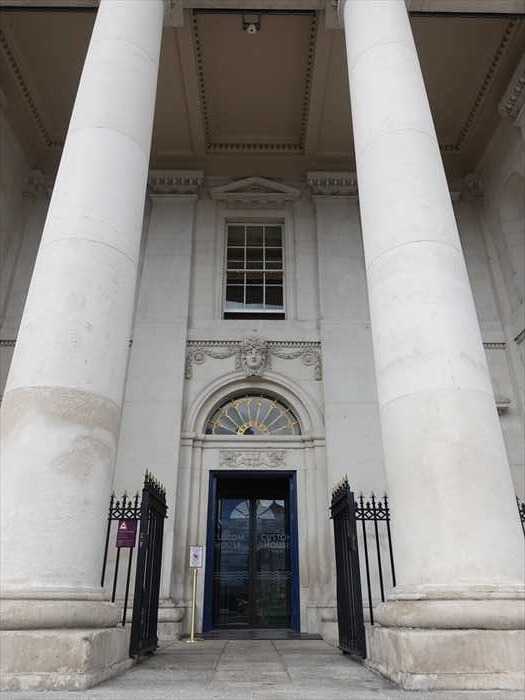
ドブリン中心部を流れるリフィー川(River Liffey)に架かる
「 タルボット記念橋・Talbot Memorial Bridge 」を見る。

「 タルボット記念橋・Talbot Memorial Bridge 」の袂の建物を見る。
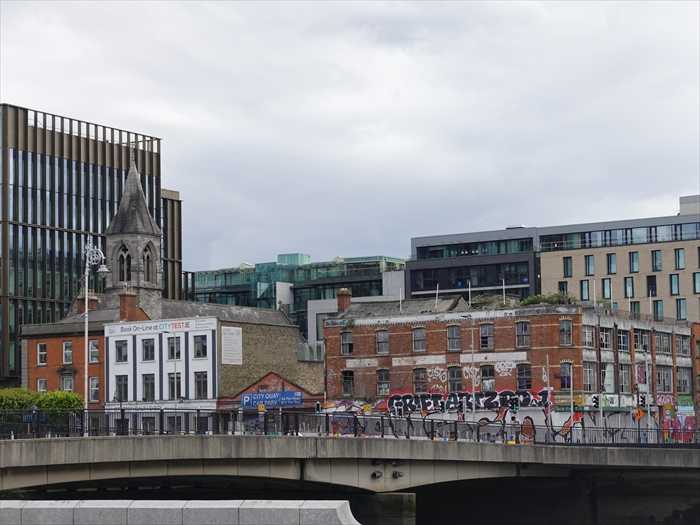
前方に現れたのが ビジネス センター「IFSC House」。
象徴的なオフィスビルで、金融業や多国籍企業が集中するエリアの一部を構成 と。

「 IFSC HOUSE 」と。
International Financial Services Centre(国際金融サービスセンター) 。
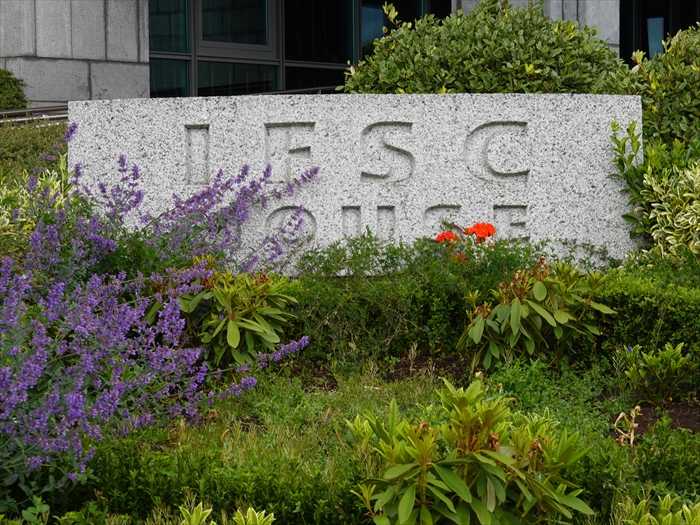
その先にあったのが、アイルランド・ダブリン港エリアにある非常に 特徴的な可動橋
Scherzer Rolling Lift Bridges(シャーツァー式転轍可動橋) 」。
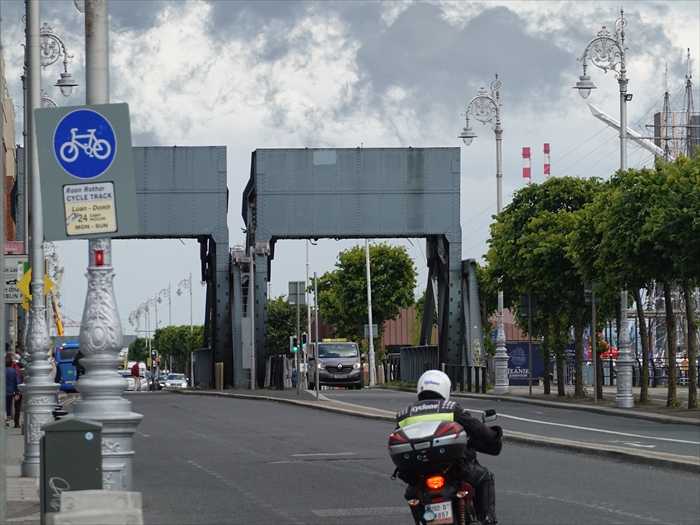


これは 1913年の「Scherzer Rolling Lift Bridge Company」(米シカゴ)による
広告(Ad) で、当時の可動橋技術の中でも特に画期的だった Scherzer式跳ね上げ可動橋
(Rolling Lift Bridge) を大々的に宣伝する内容。
「 Scherzer ROLLING Lift Bridges cost less than other movable bridges
because they are the Extreme of Simplicity.
Scherzer ROLLING Lift Bridges are used all over the world because they use the only
principle for moving a bridge that anyone would consider for moving any kind of
land traffic. They ROLL (or rock) a short distance on part of a wheel, just as all
land traffic rolls all distances on whole wheels.
(Deep waterways carry raw materials inland. Factories increase, population and land
values go up. Railroads must distribute the finished materials away from the deep
waterway. Everyone is benefited because business is stimulated.)
【 シャーツァー・ローリング・リフト・ブリッジは、他の可動橋よりもコストがかかりません。

「 タルボット記念橋・Talbot Memorial Bridge 」を再び。
その先に St. Mark’s Church(旧教会施設) も再び。
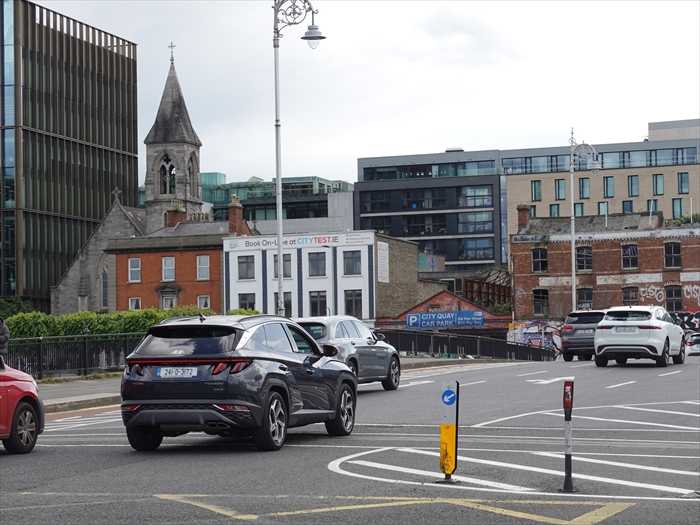
リフィー川北岸の遊歩道、FSC地区(International Financial Services Centre)にある
有名な彫刻群・ Famine Memorial(飢饉記念像) 👉️リンク。
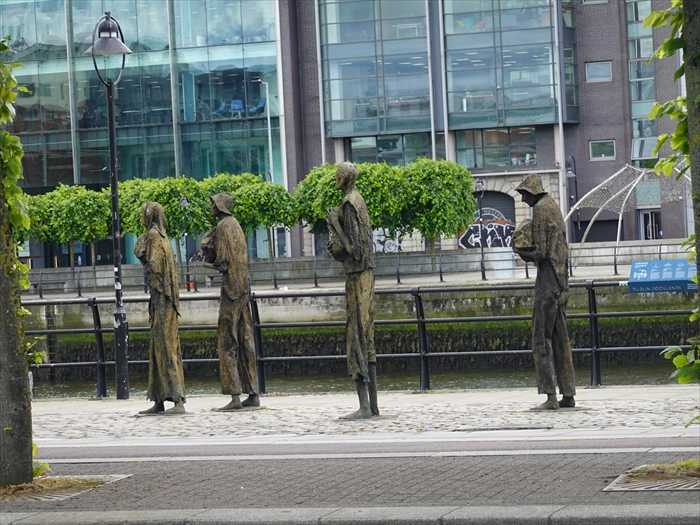
この彫刻群は、1845年~1852年の「アイルランド大飢饉(Great Famine)」で
餓死・移民を余儀なくされた無数の人々を追悼するものであると。
彫像の特徴:
・合計7体のやせ細った男女(大人・子ども)
・手に鍋、布包み、赤ん坊を抱く姿
・足元は裸足やぼろぼろの靴
・前かがみで港に向かって歩き出す姿勢(=「出国」・「脱出」)表すもの:
・飢餓
・絶望
・故郷を捨てて移民船に向かう人々の行進
・アイルランドの移民史と記憶の継承
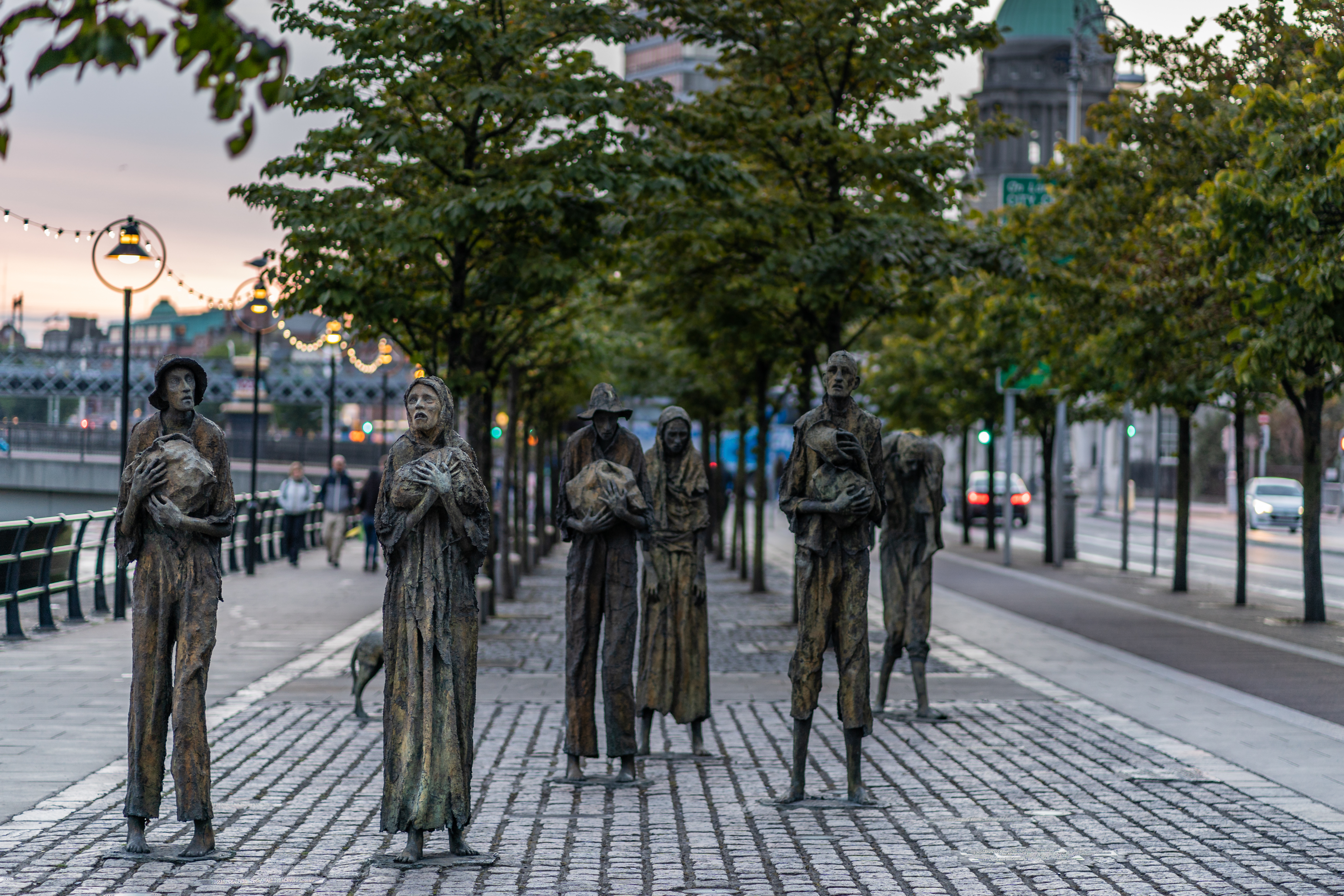
写真左側の人物像:
・フードをかぶった女性
・胸に赤ん坊を抱きしめるように持ち、両手の指を大きく開いた姿
・憔悴した表情で、やや上を見上げている
・→ 母性・苦しみ・祈り・絶望の象徴右側の人物像:
・帽子をかぶった男性
・腕に大きな包み(布に包まれた荷物)を抱える
・頭を少し下げ、視線は落ちているように見える
・→ 労働者・責任・疲労・喪失の象徴
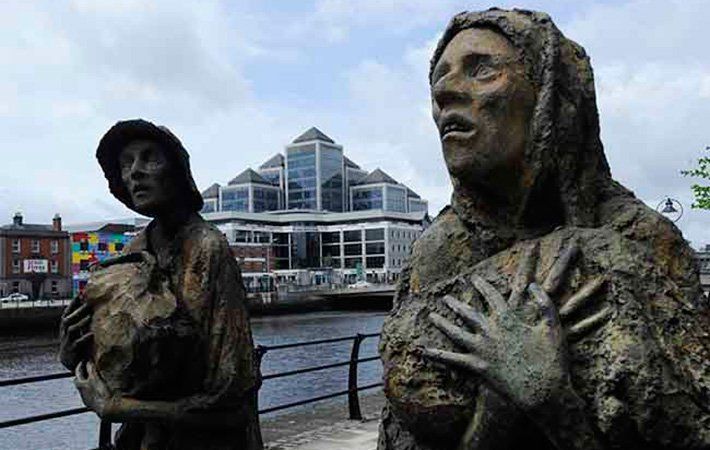
肩に子どもを背負った父親像 。

正面から。

そして、この後に訪ねた
EPIC The Irish Emigration Museum(EPIC アイルランド移民博物館)
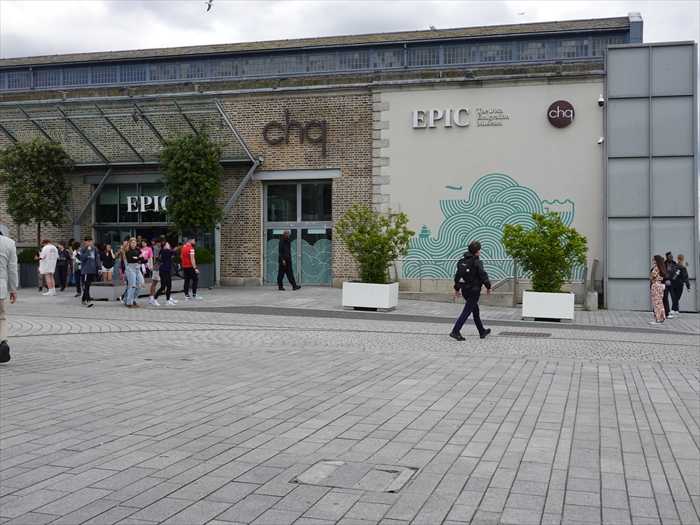
EPIC アイルランド移民博物館の前にあった歴史的構造物
Customs House Dock Entrance Arch(カスタムハウス・ドック入口アーチ) 。

そして4人で入館。

EPIC The Irish Emigration Museum 。
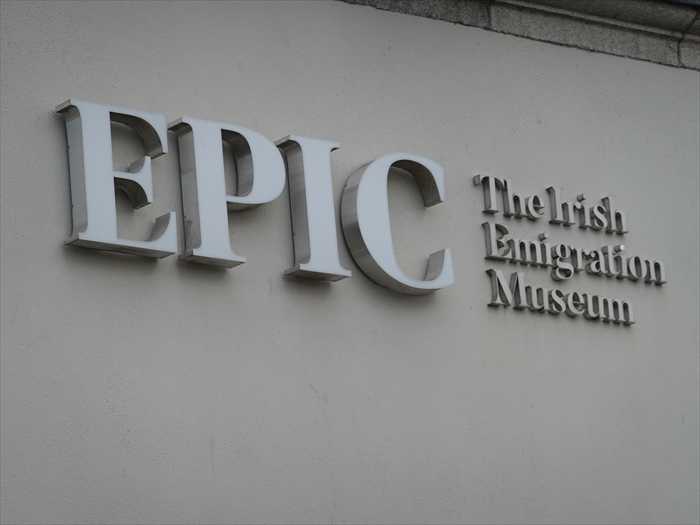
入館受付 。

「 WELCOME
インタラクティブな映像ガイドには館長?の姿が。

「 PASSAGE OF YEARS(年月の経過) 」
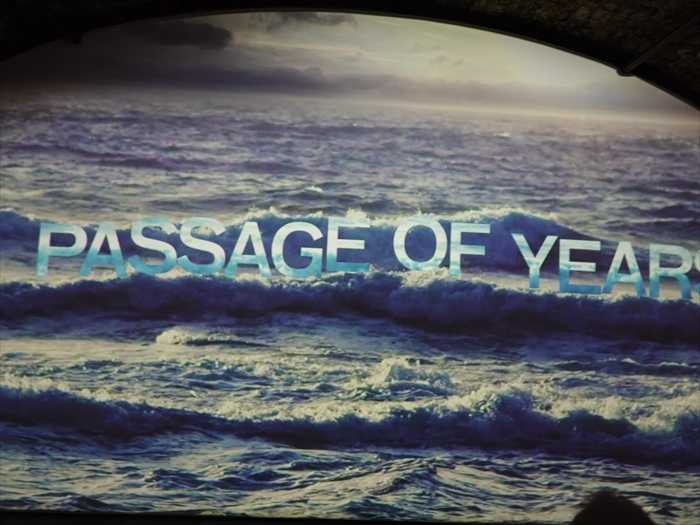
Galleryの入口 。

展示エリアのひとつには、来館者が写真や映像を撮るスポットとしても設計された
「体験型・視覚演出空間」も。
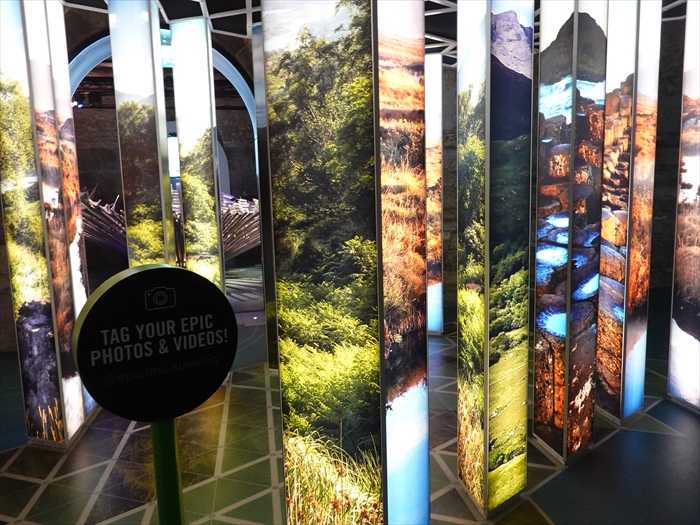
「An Open Island(開かれた島)」 というパネル。

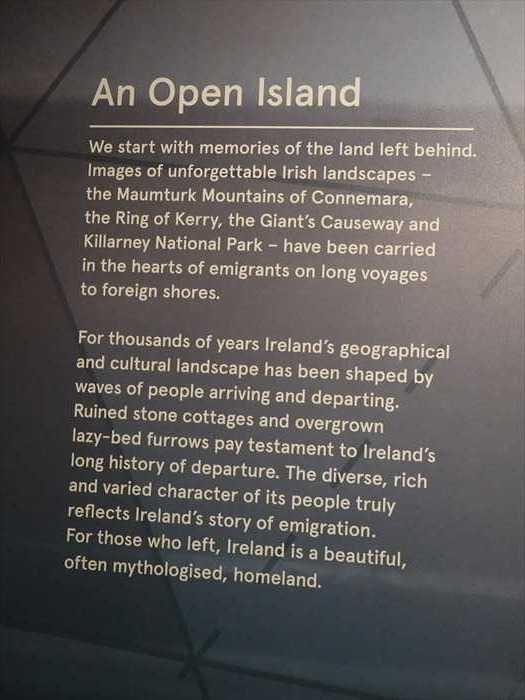
金属製の帆船模型が複数並び、背景には映像モニターが。
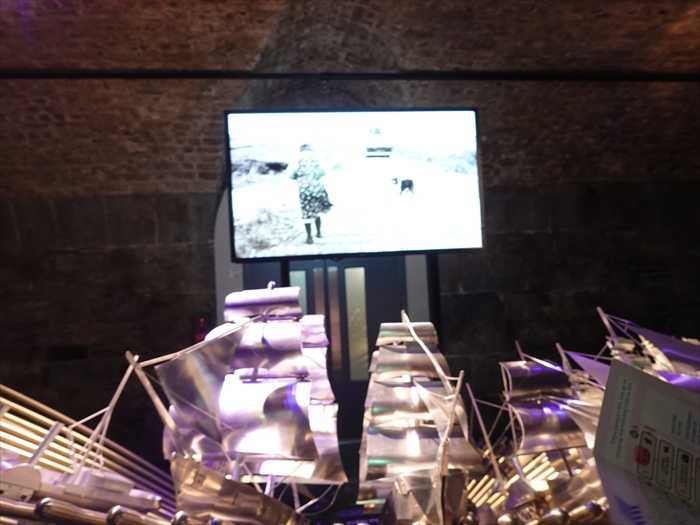
「Watch the routes travelled by Irish emigrants over the centuries」
【アイルランド移民が何世紀にもわたって辿ったルートをご覧ください】
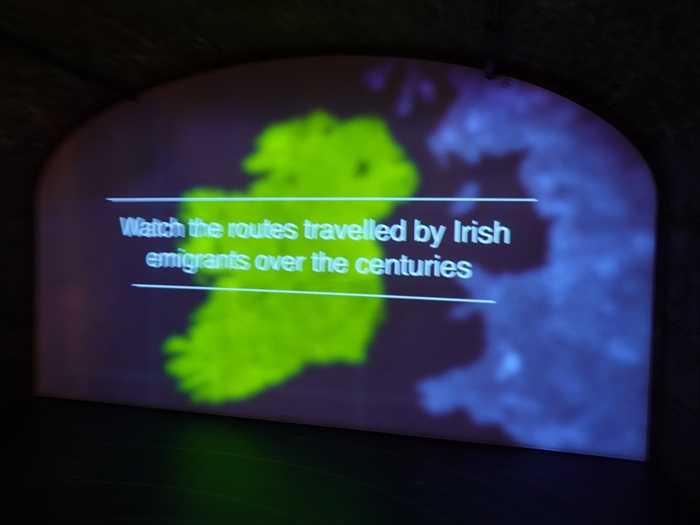
アイルランドからの移民の出発地点と初期の航路を示す 展示の一部。
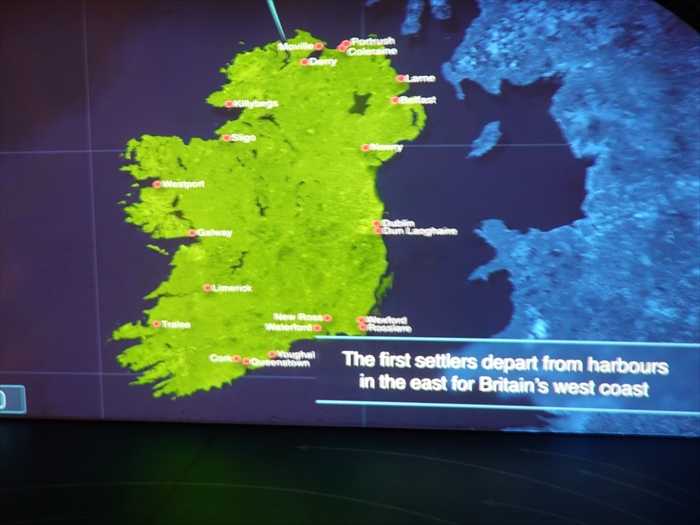
アイルランドから世界各地へと広がった移民ルート を視覚的に示した地球儀型の
インスタレーション。
イギリス、ヨーロッパ、北米、南米へと次々に。

Gallery 3: "The Journey"であっただろうか?
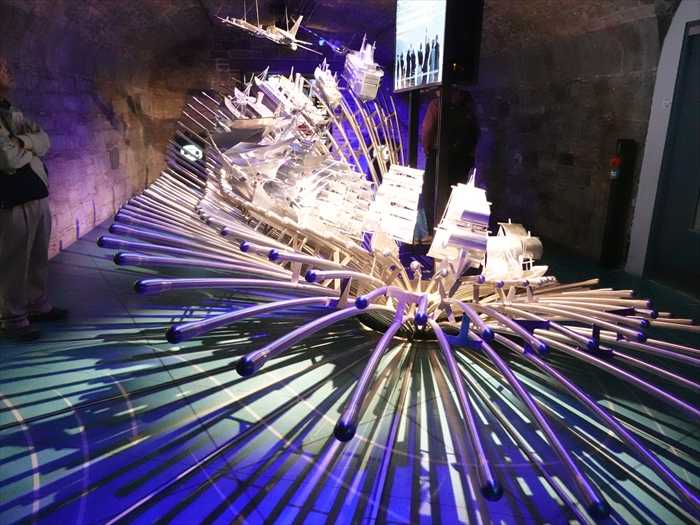
Gallery 「 Arriving in a New Land"(新天地への到着) 」 に関係する展示。
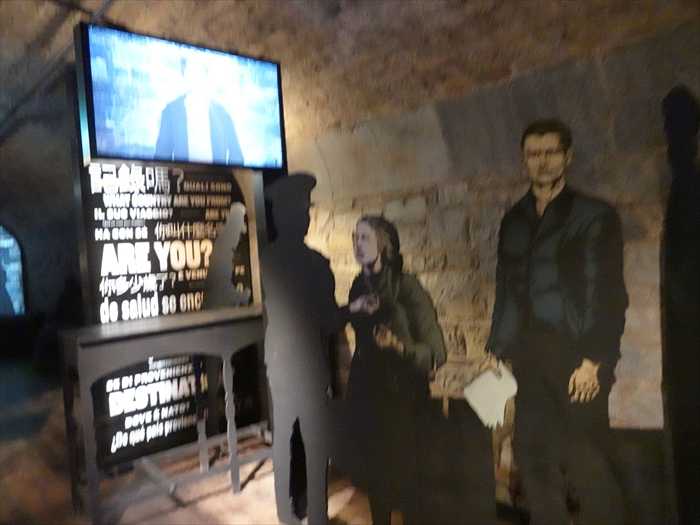
Howard Family Trunk(ハワード家のトランク) 。
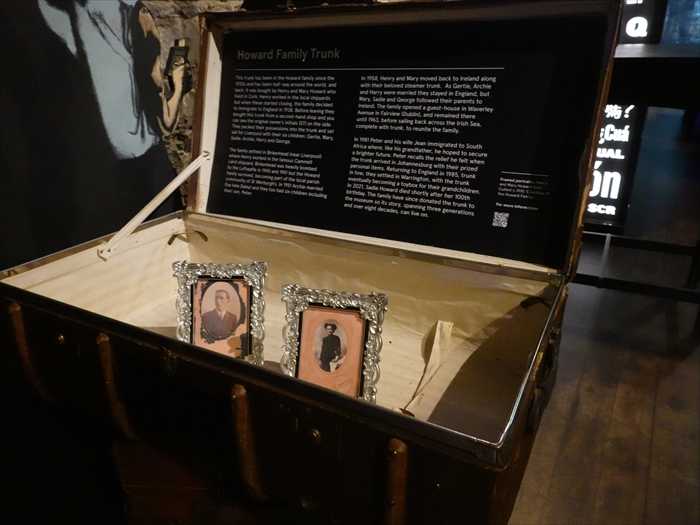
「 Howard Family Trunk
donated the trunk to the museum so its story, spanning three generations and
over eight decades, can live on. 」
【 ハワード家のトランク
語り継がれることとなったのです。 】

歴史を通じて国外へ渡ったアイルランド移民を代表する6名 を示しています。背景の映像に
表示されている名前と人物像は以下の通り。
左から右へ
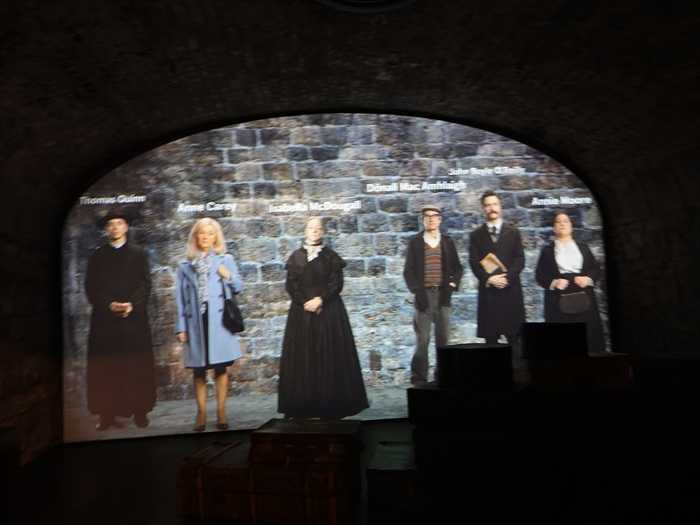
「TEACHING(教育)」
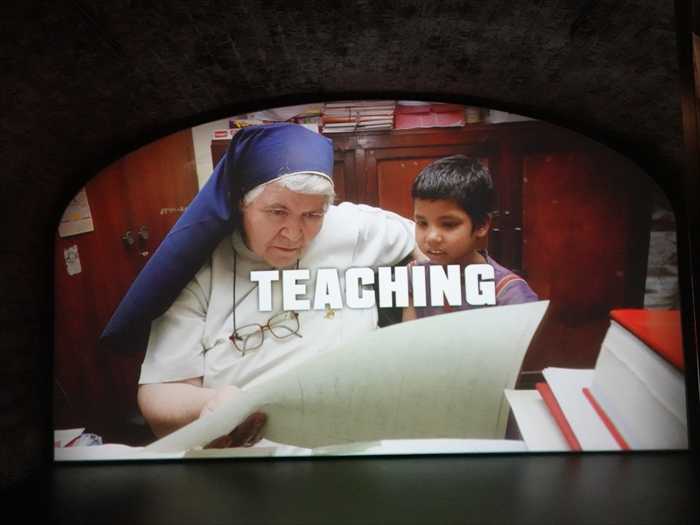
美しい ステンドグラス風円柱 。
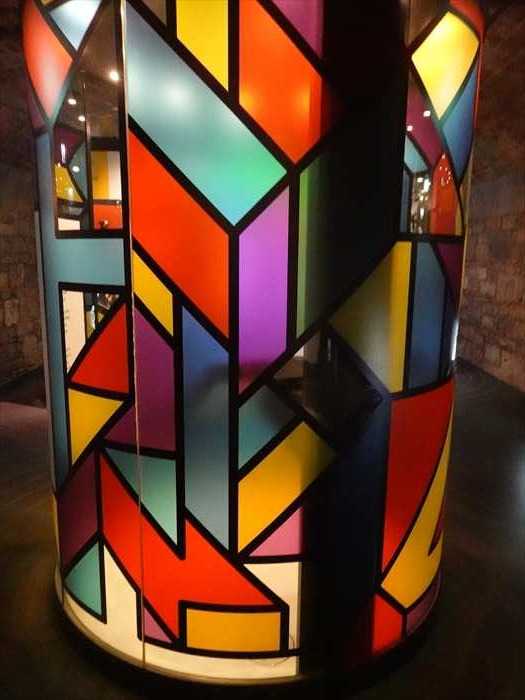
「UNITING COMMUNITIES」
【地域の人々を結びつける共同体を団結させる】

「 Education
the benefits of education to less privileged parts of the world. There are strong ties
particularly between Ireland and some educational systems in Africa. For example,
the Jesuit Father Michael Kelly has been referred to as the Grandfather of Zambian
education, having lived there for over 50 years, establishing schools and becoming
a leader in the campaign against HIV and Aids.」
【 教育
「 Christianity
aid to those of all nations and faiths. Today, many Irish emigrants continue to leave
the island to provide aid to those who need it most.」
【 キリスト教
必要とする人々に提供しました。今日でも多くのアイルランド人移民が、援助を必要とする
人々を助けるために島を後にし続けているのです。 】

・・・ もどる ・・・
・・・ つづく ・・・
Custom House Visitor Centre・歴史博物館。
アイルランド政府によって整備された公共の歴史展示施設で、アイルランドの近代史と
カスタム・ハウス自体の歴史を中心に紹介していた。

この日は入館しなかったが Custom House Visitor Centre の展示内容
をネットから。
1. 1921年「カスタム・ハウス襲撃(Burning of the Custom House)」
・アイルランド独立戦争中(1921年5月25日)のIRAによる放火攻撃。
・建物の大部分が炎上し、多数のアイルランド共和国軍兵士が捕えられた歴史的事件。
・展示では:
・焼失したアーカイブ(記録)と建物の被害状況
・攻撃の政治的・戦略的背景
・英国当局の反応
・関係者の証言や回想録(映像・音声あり)
・復元作業の記録(1930年代の再建)
2. カスタム・ハウスの建築史とジェームズ・ガンドン
・建築家 James Gandon による設計の背景(1780年代)
・建築素材(ポータランド石、アイルランド産石灰岩など)
・ドームや彫像、河川女神像の象徴的意味
・建設当時のダブリンの街の姿と経済活動(港町としての重要性)
3. 税関・港湾とアイルランド経済の発展
・18~19世紀の関税行政の中枢としての役割
・輸出入品の管理、税金徴収の仕組み
・港湾労働者や役人の生活、制服、帳簿など実物展示
・アイルランドの商業・物流の変遷も紹介
4. アイルランド国家の形成とダブリンの変遷
・アイルランド独立(1922)への道のりを描く年表と解説
・カスタム・ハウスが政治の象徴として果たした役割
・国旗、憲法草案、ダブリンの都市計画なども展示
5. 展示の形式
・パネル展示(英語・一部はアイルランド語との併記)
・タッチスクリーンのインタラクティブ解説
・模型(建物全体・ドーム内部など)
・子ども向けワークシート、学校団体用ガイドあり
リフィー川越しの Custom House Visitor Centreの写真をネットから。
リフィー川越しの Custom House Visitor Centreの写真をネットから。
カスタム・ハウス(The Custom House)正面上部に掲げられている石造の紋章(紋章装飾)
を
ズームして。

下記写真はネットから。
正面ファサードの特徴
1. 中央ドーム:
・緑青色の銅製ドーム
・ドーム下には四方に時計(四面時計)
・頂上に立つ像は 「Commerce(商業)」の女神像
で、商業の象徴であると。
2. コリント式列柱(中央玄関部):
2. コリント式列柱(中央玄関部):
・大きな柱で構成されたポーチ
・ギリシャ神殿風のペディメント(三角破風)には彫像が並ぶ
3.彫像群:
・ペディメントや屋上にはアイルランドの主要河川を象徴する川の女神像が多数配置されている
・建物の東西両端にも彫像装飾が見える(王冠付きの盾とライオンなど)
4.建築様式:
・新古典主義建築(Neoclassical)
・対称的な構造、アーチ、列柱、幾何学的均整が特徴

頂上に立つ 「Commerce(商業)」 の女神像を見上げて。

正面から。(ネットから)
左から 順に
1. Mercury(マーキュリー)
・左端、翼のある兜と杖(カドゥケウス)を持つ青年神。
・商業・流通・旅行の守護神。
・古代ローマ神話由来、商業建築によく登場する。
2. Plenty(豊穣)
・農産物・穀物・花輪などを持つ女性像。
・アイルランドの土地の豊かさ、穀物貿易の象徴。
3. Industry(勤労)
・道具や織機、歯車などを持つことが多い。
・この像は女性で、衣服を整えながら堂々と立ち、勤勉と産業を象徴。
・中央の正面寄りに配置。
4. Neptune(ネプチューン)
・最右端、三叉槍(トライデント)を持つ男性像。
・海の神として港湾都市ダブリンの性格を示す。
・アイルランドの貿易が海上輸送に依存していたことを象徴。
掲げられた2つの旗
・左側:アイルランド国旗(緑・白・橙)
・独立国家としてのアイルランドを象徴
・右側:欧州連合旗(青地に12星)
・EU加盟国としての現在のアイルランドの立場を示す

カスタム・ハウス(The Custom House, Dublin)の ドームを斜めに見上げて

カスタム・ハウス(The Custom House, Dublin) の 中央正面入口(ポーチ部) を見上げて。
巨大なコリント式円柱 ・正面入口は2本の巨大な円柱に支えられたポルティコ(列柱玄関)に
包まれています。
・柱頭はこの角度では見えないが、通常この建物ではコリント式(花飾り付き)を採用。
アーチ上部の彫刻(ケンタウロス風の顔)
・ファンライト上部には、ギリシャ・ローマ風の神話的な顔面彫刻(キメラ?)が。
・恐らく建物の設計者 ジェームズ・ガンドンが用いた装飾様式で、知性・威厳・監視を
象徴するモチーフと。
象徴するモチーフと。
・顔の上にはリボン装飾や小花模様が配置され、全体として荘厳かつ幾何学的に
整えられていた。
整えられていた。

ドブリン中心部を流れるリフィー川(River Liffey)に架かる
「 タルボット記念橋・Talbot Memorial Bridge 」を見る。

「 タルボット記念橋・Talbot Memorial Bridge 」の袂の建物を見る。
とんがり屋根の小さな塔は、Busáras(ダブリン中央バスターミナル) の近隣にある
St. Mark’s Church(旧教会施設) の一部 。
中央右赤レンガの建物は廃墟化した元倉庫または住居跡であろうか?。
St. Mark’s Church(旧教会施設) の一部 。
中央右赤レンガの建物は廃墟化した元倉庫または住居跡であろうか?。
おそらく19世紀後半~20世紀初頭に建てられたレンガ造の典型的ジョージアン様式。

前方に現れたのが ビジネス センター「IFSC House」。
象徴的なオフィスビルで、金融業や多国籍企業が集中するエリアの一部を構成 と。

「 IFSC HOUSE 」と。
International Financial Services Centre(国際金融サービスセンター) 。

その先にあったのが、アイルランド・ダブリン港エリアにある非常に 特徴的な可動橋
Scherzer Rolling Lift Bridges(シャーツァー式転轍可動橋) 」。

地元では「 North Wall Scherzer Bridges
」とも呼ばれていると。
ダブリン港のNorth Wall Quay(ノースウォール埠頭)に架かっている、2連の小型可動橋。

ローリングリフトブリッジ(ROLLING Lift Bridge)は、可動橋の一種で、水上交通を通過させる
ために跳ね上げる際に、転動機構を使用して開閉する橋。
ために跳ね上げる際に、転動機構を使用して開閉する橋。
この橋は、カウンターウェイトを使用して、橋が開く際の動きをバランスさせているのだ と。

これは 1913年の「Scherzer Rolling Lift Bridge Company」(米シカゴ)による
広告(Ad) で、当時の可動橋技術の中でも特に画期的だった Scherzer式跳ね上げ可動橋
(Rolling Lift Bridge) を大々的に宣伝する内容。
「 Scherzer ROLLING Lift Bridges cost less than other movable bridges
because they are the Extreme of Simplicity.
Scherzer ROLLING Lift Bridges are used all over the world because they use the only
principle for moving a bridge that anyone would consider for moving any kind of
land traffic. They ROLL (or rock) a short distance on part of a wheel, just as all
land traffic rolls all distances on whole wheels.
But Scherzer ROLLING Lift Bridges have a great advantage over other ROLLING stock.
They do not use friction-causing axles, trunnions and journals to support the bridge.
Using only part of a wheel, they do away with this constant trouble and expense.
They do not use friction-causing axles, trunnions and journals to support the bridge.
Using only part of a wheel, they do away with this constant trouble and expense.
Scherzer ROLLING Lift Bridges ROLL upward and back awayfrom the water, leaving the
channel entirely clear in thirtyseconds, also forming a signal and barrier against accidents.
channel entirely clear in thirtyseconds, also forming a signal and barrier against accidents.
Or they roll forward and down, closing the channel in thirtyseconds. Traffic has practically
no interruption becauseScherzer ROLLING Lift Bridges do not start to open until avessel
is almost upon them and they close before it is morethan a few feet away.
no interruption becauseScherzer ROLLING Lift Bridges do not start to open until avessel
is almost upon them and they close before it is morethan a few feet away.
Scherzer ROLLING Lift Bridges combine economy, simplicity,
efficiency. They adapt to movable bridges the greatest
mechanical principle—the ROLLING principle.
Scherzer Bridge foundations are simpler and cost less because Scherzer Bridges are
simpler and weigh less than any other movable bridge.
simpler and weigh less than any other movable bridge.
Scherzer
ROLLING Lift Bridge Co.
Main office: Monadnock Block, Chicago, U.S.A.」 (Deep waterways carry raw materials inland. Factories increase, population and land
values go up. Railroads must distribute the finished materials away from the deep
waterway. Everyone is benefited because business is stimulated.)
【 シャーツァー・ローリング・リフト・ブリッジは、他の可動橋よりもコストがかかりません。
なぜなら、それは極限まで単純化された構造だからです。
シャーツァー式ローリング・リフト・ブリッジは世界中で使われています。
というのも、この橋は「橋を動かす」という行為において、あらゆる陸上交通の移動手段として
誰もが思い浮かべる唯一の原理を応用しているからです。
誰もが思い浮かべる唯一の原理を応用しているからです。
つまり、橋は車輪の一部の上を転がる(または揺れる)だけで短い距離を移動します。
これは、すべての陸上交通が完全な車輪によってあらゆる距離を移動するのと同じ理屈です。
しかし、シャーツァー・ローリング・リフト・ブリッジには、他のローリング式構造と比べて
大きな利点があります。それは、摩擦の原因となる車軸やトラニオン(旋回軸)、軸受けを
使用せず、橋を支えているという点です。
大きな利点があります。それは、摩擦の原因となる車軸やトラニオン(旋回軸)、軸受けを
使用せず、橋を支えているという点です。
車輪の一部だけを使うことで、これらの絶え間ないトラブルと費用を排除しています。
シャーツァー式ローリング・リフト・ブリッジは、橋桁を水面から上方へ、かつ後方へ転がす
ようにして持ち上げ、わずか30秒で水路を完全に開放します。
ようにして持ち上げ、わずか30秒で水路を完全に開放します。
この動作はまた、事故防止のための信号や障壁の役割も果たします。
また、橋は前方に転がりながら降下し、水路を閉じるのにも30秒しかかかりません。
交通はほとんど妨げられません。
というのも、シャーツァー橋は船がほぼ至近まで近づくまで開き始めず、船が通過すると
数フィート以内で閉じるからです。
数フィート以内で閉じるからです。
シャーツァー・ローリング・リフト・ブリッジは、経済性、簡素性、効率性を兼ね備えています。
この橋は、可動橋に最も優れた機械原理——ローリング(転がす)原理を適用しているのです。
シャーツァー橋の基礎構造はより簡単で、建設費も安く済みます。
なぜなら、シャーツァー橋は他のどんな可動橋よりも構造が単純で、重量も軽いからです。
(深い水路は、原材料を内陸部へ運びます。
工場が増え、人口が増加し、土地の価値も上昇します。
鉄道は、完成した製品をこの深い水路から各地へ配送しなければなりません。
こうして経済活動が活性化することで、誰もが恩恵を受けるのです。)
シャーツァー・ローリング・リフト・ブリッジ社
本社:米国イリノイ州シカゴ、モナドノック・ブロック】
「 タルボット記念橋・Talbot Memorial Bridge 」を再び。
その先に St. Mark’s Church(旧教会施設) も再び。

リフィー川北岸の遊歩道、FSC地区(International Financial Services Centre)にある
有名な彫刻群・ Famine Memorial(飢饉記念像) 👉️リンク。
作者:
Rowan Gillespie(ローワン・ギレスピー)
アイルランドの著名な彫刻家(1948年生)
制作・設置:
1997年
アイルランド政府とIFSCの再開発プロジェクトの一環で設置

この彫刻群は、1845年~1852年の「アイルランド大飢饉(Great Famine)」で
餓死・移民を余儀なくされた無数の人々を追悼するものであると。
彫像の特徴:
・合計7体のやせ細った男女(大人・子ども)
・手に鍋、布包み、赤ん坊を抱く姿
・足元は裸足やぼろぼろの靴
・前かがみで港に向かって歩き出す姿勢(=「出国」・「脱出」)表すもの:
・飢餓
・絶望
・故郷を捨てて移民船に向かう人々の行進
・アイルランドの移民史と記憶の継承

写真左側の人物像:
・フードをかぶった女性
・胸に赤ん坊を抱きしめるように持ち、両手の指を大きく開いた姿
・憔悴した表情で、やや上を見上げている
・→ 母性・苦しみ・祈り・絶望の象徴右側の人物像:
・帽子をかぶった男性
・腕に大きな包み(布に包まれた荷物)を抱える
・頭を少し下げ、視線は落ちているように見える
・→ 労働者・責任・疲労・喪失の象徴

肩に子どもを背負った父親像 。
骨と皮ばかりになったような痩せた男性が、気を失った、または死亡した子どもを
肩に背負って歩いている。
肩に背負って歩いている。
男性の首は前に垂れ、極度の疲労・悲しみ・絶望感が表情と姿勢から読み取れます。
子どもはだらりと垂れ下がり、生気がない姿が。

正面から。
目:
大きく開き、焦点の定まらない瞳。
→ 飢餓による衰弱、または喪失による絶望を象徴。
口:
半開きで、歯がむき出しになっている。
→ 言葉を失った苦しみ、あるいは叫びを抑えた状態を表す。
皮膚:
ひび割れ、荒れた質感。
→ 飢饉による病や栄養失調、疲労の蓄積を表現。
頭部全体:
うつむきがちに前に傾いている。
→ 負担の重さ、精神的な疲弊。

そして、この後に訪ねた
EPIC The Irish Emigration Museum(EPIC アイルランド移民博物館)

EPIC アイルランド移民博物館の前にあった歴史的構造物
Customs House Dock Entrance Arch(カスタムハウス・ドック入口アーチ) 。
建設時期:
18世紀末(約1790年代)
由来:
元々はこの一帯にあった 倉庫施設の出入り口アーチの一部
関連施設:
すぐ隣にある建物は、かつての「Customs House Tobacco Store」
(税関たばこ倉庫)で、現在は「CHQビル」として再活用されていた。
構造: 灰色の切石(石灰岩)を積み上げた堅牢な造り
(税関たばこ倉庫)で、現在は「CHQビル」として再活用されていた。
構造: 灰色の切石(石灰岩)を積み上げた堅牢な造り
アーチ部は放射状のヴォールト状(円弧構造)

そして4人で入館。

EPIC The Irish Emigration Museum 。
「EPIC」は:
"Every Person Is Connected
(すべての人はつながっている)
"

入館受付 。

「 WELCOME
At the heart of Ireland's story is the movement of our people. The Irish identity
has been shaped by migration. People left and still leave our island for many reasons,
some pushed by circumstances at home, others pulled by opportunities abroad.
Many emigrant stories are linked by common motivations and shared experiences.
has been shaped by migration. People left and still leave our island for many reasons,
some pushed by circumstances at home, others pulled by opportunities abroad.
Many emigrant stories are linked by common motivations and shared experiences.
Today, these emigrants and their descendants number over 70 million people, in all
four corners of the globe. Here, we tell their stories.」
【 ようこそ
four corners of the globe. Here, we tell their stories.」
【 ようこそ
アイルランドの物語の中心には、私たちの人々の移動があります。アイルランド人としての
アイデンティティは、移民によって形づくられてきました。人々はさまざまな理由でこの島を
去り、そして今も去り続けています。なかには故郷の事情に追われるようにして、また
なかには海外での機会に引き寄せられて旅立った人もいます。多くの移民の物語は、共通する
動機や体験によって結ばれています。
アイデンティティは、移民によって形づくられてきました。人々はさまざまな理由でこの島を
去り、そして今も去り続けています。なかには故郷の事情に追われるようにして、また
なかには海外での機会に引き寄せられて旅立った人もいます。多くの移民の物語は、共通する
動機や体験によって結ばれています。
現在では、これらの移民とその子孫の数は世界中で7,000万人以上にのぼります。ここでは、
彼らの物語を語っていきます】
彼らの物語を語っていきます】

インタラクティブな映像ガイドには館長?の姿が。
展示ギャラリーのテーマ構成と主な内容
EPICの展示は以下4つのカテゴリーに分類されている と。
1. Migration(移民の歴史) ギャラリー(ギャラリー1〜2)
・紀元500年以降のアイルランド人の移民パターンを紹介。
・宗教布教、飢饉(Great Famine)、社会・宗教的迫害、犯罪者の流刑、外国紛争への
関与などをテーマにした展示。
関与などをテーマにした展示。
2. Motivation(移民の動機)(ギャラリー4〜7)
・飢饉や貧困、宗教迫害、機会追求など、移民を決断した背景を具体的な事例と共に解説。
3. Influence(移民が与えた影響)(ギャラリー8〜18)
・政治、ビジネス、アート、文学、科学、音楽、スポーツなど、世界中で活躍した
アイルランド出身者の功績紹介。
アイルランド出身者の功績紹介。
・グレース・ケリー、ジョン・F・ケネディ、ブラッド・オバマや、意外なルーツをたどれば
チェ・ゲバラの先祖もアイルランド出身など、約300名以上の移民に関する
ストーリーを収録
4. Diaspora Today(今日のディアスポラ)(ギャラリー19〜20)
・世界全体でアイルランド系人口が7,000万人以上に及んでいる現状を示唆。
チェ・ゲバラの先祖もアイルランド出身など、約300名以上の移民に関する
ストーリーを収録
4. Diaspora Today(今日のディアスポラ)(ギャラリー19〜20)
・世界全体でアイルランド系人口が7,000万人以上に及んでいる現状を示唆。
・「Irish Family History Centre」で個人の家族史やDNA調査が可能な
サービスコーナーも装備
サービスコーナーも装備

「 PASSAGE OF YEARS(年月の経過) 」

Galleryの入口 。

展示エリアのひとつには、来館者が写真や映像を撮るスポットとしても設計された
「体験型・視覚演出空間」も。
光の柱(LEDパネル)の通路:
柱状のLEDディスプレイに自然風景(海・川・森など)が映し出されていた。

「An Open Island(開かれた島)」 というパネル。

「 An Open Island
We start with memories of the land left behind.Images of unforgettable Irish landscapes –
the Maumturk Mountains of Connemara,the Ring of Kerry, the Giant’s Causeway and
Killarney National Park – have been carriedin the hearts of emigrants on long voyages
Killarney National Park – have been carriedin the hearts of emigrants on long voyages
to foreign shores.
For thousands of years Ireland’s geographicaland cultural landscape has been shaped by
waves of people arriving and departing.Ruined stone cottages and overgrown
lazy-bed furrows pay testament to Ireland’slong history of departure. The diverse, rich
and varied character of its people trulyreflects Ireland’s story of emigration.
For those who left, Ireland is a beautiful,often mythologised, homeland.」
【 開かれた島
【 開かれた島
私たちは、置いてきた土地の記憶から出発します。
忘れがたいアイルランドの風景──コネマラのマウムターク山脈、ケリー周遊路、ジャイアンツ・
コーズウェイ、キラーニー国立公園──これらの情景は、遠く異国の地への長い航海の中で、
移民たちの心に抱かれ続けてきました。
コーズウェイ、キラーニー国立公園──これらの情景は、遠く異国の地への長い航海の中で、
移民たちの心に抱かれ続けてきました。
何千年にもわたり、アイルランドの地理的・文化的風景は、人々の「到来」と「旅立ち」の波に
よって形づくられてきました。
よって形づくられてきました。
崩れかけた石造りのコテージや、草に覆われたレイジー・ベッド(伝統的な畝)は、この地が
長きにわたって「旅立ちの地」であったことの証しです。
長きにわたって「旅立ちの地」であったことの証しです。
アイルランドの人々の多様で豊かな個性は、まさにこの移民の歴史を物語っています。
故郷を後にした人々にとって、アイルランドは美しく、そしてしばしば神話的に語られる
「心の故郷」なのです。】
「心の故郷」なのです。】

金属製の帆船模型が複数並び、背景には映像モニターが。

「Watch the routes travelled by Irish emigrants over the centuries」
【アイルランド移民が何世紀にもわたって辿ったルートをご覧ください】

アイルランドからの移民の出発地点と初期の航路を示す 展示の一部。
地図にはアイルランド全土の主要な港町が赤い点で示されていた。
白字の説明文:
"The first settlers depart from harbours in the east for Britain's west coast"
【最初の移民たちは、アイルランド東部の港からイギリス西海岸へと出発した】
これは、アイルランドからの初期の移住者(settlers)が、主にアイルランド東海岸の港を
利用して、イングランド・ウェールズ・スコットランドの西海岸へ渡っていったことを
示していた。
利用して、イングランド・ウェールズ・スコットランドの西海岸へ渡っていったことを
示していた。

アイルランドから世界各地へと広がった移民ルート を視覚的に示した地球儀型の
インスタレーション。
イギリス、ヨーロッパ、北米、南米へと次々に。

Gallery 3: "The Journey"であっただろうか?
放射状に広がる無数の金属製オール(櫂)は、アイルランドから世界へと放たれる無数の
移民たちの出発を象徴。
移民たちの出発を象徴。
上部に浮かぶように設置された帆船模型は、時代と共に使われてきた移民船の発展を表す:
・帆船(18〜19世紀)
・蒸気船(19世紀中頃〜)
・航空機(20世紀中盤以降、奥の方にジェット機らしき形も)

Gallery 「 Arriving in a New Land"(新天地への到着) 」 に関係する展示。

Howard Family Trunk(ハワード家のトランク) 。

「 Howard Family Trunk
This trunk has been in the Howard family since the 1930s and has been half-way around
the world, and back. It was bought by Henry and Mary Howard who lived in Cork.
Henry worked in the local shipyards but when these started closing, the family decided to emigrate to England in 1938. Before leaving they bought this trunk from a second-hand
shop and you can see the original owner's initials (ST) on the side.
the world, and back. It was bought by Henry and Mary Howard who lived in Cork.
Henry worked in the local shipyards but when these started closing, the family decided to emigrate to England in 1938. Before leaving they bought this trunk from a second-hand
shop and you can see the original owner's initials (ST) on the side.
They packed their possessions into the trunk and set sail for Liverpool with their six
children: Gertie, Mary, Sadie, Archie, Harry and George.
children: Gertie, Mary, Sadie, Archie, Harry and George.
The family settled in Birkenhead (near Liverpool) where Henry worked in the famous
Cammell Laird shipyard. Birkenhead was heavily bombed by the Luftwaffe in 1940 and
1941 but the Howard family survived, becoming part of the local parish community of
St Werburgh’s. In 1951 Archie married Eva (née Daley) and they too had six children
including their son, Peter.
Cammell Laird shipyard. Birkenhead was heavily bombed by the Luftwaffe in 1940 and
1941 but the Howard family survived, becoming part of the local parish community of
St Werburgh’s. In 1951 Archie married Eva (née Daley) and they too had six children
including their son, Peter.
In 1958, Henry and Mary moved back to Ireland along with their beloved steamer
trunk. As Gertie, Archie and Harry were married they stayed in England, but Mary,
Sadie and George followed their parents to Ireland. The family opened a guest-house in
Waverley Avenue in Fairview (Dublin), and remained there until 1963, before sailing
back across the Irish Sea, complete with trunk, to reunite the family.
trunk. As Gertie, Archie and Harry were married they stayed in England, but Mary,
Sadie and George followed their parents to Ireland. The family opened a guest-house in
Waverley Avenue in Fairview (Dublin), and remained there until 1963, before sailing
back across the Irish Sea, complete with trunk, to reunite the family.
In 1981 Peter and his wife Jean immigrated to South Africa where, like his grandfather,
he hoped to secure a brighter future. Peter recalls the relief he felt when the trunk
arrived in Johannesburg with their personal items. Returning to England in 1985,
trunk in tow, they settled in Warrington, with the trunk eventually becoming a toy box
for their grandchildren.
In 2021, Sadie Howard died shortly after her 100th birthday. The family have sincehe hoped to secure a brighter future. Peter recalls the relief he felt when the trunk
arrived in Johannesburg with their personal items. Returning to England in 1985,
trunk in tow, they settled in Warrington, with the trunk eventually becoming a toy box
for their grandchildren.
donated the trunk to the museum so its story, spanning three generations and
over eight decades, can live on. 」
【 ハワード家のトランク
このトランクは1930年代からハワード家に受け継がれており、地球の半周以上の旅をして再び
戻ってきました。
戻ってきました。
このトランクはコークに住んでいたヘンリーとメアリー・ハワード夫妻が購入したものです。
ヘンリーは地元の造船所で働いていましたが、閉鎖が始まったため、1938年に一家で
イングランドへ移住することを決断しました。出発前に彼らは中古品店でこのトランクを購入し、
側面には元の持ち主のイニシャル「ST」が見られます。
ヘンリーは地元の造船所で働いていましたが、閉鎖が始まったため、1938年に一家で
イングランドへ移住することを決断しました。出発前に彼らは中古品店でこのトランクを購入し、
側面には元の持ち主のイニシャル「ST」が見られます。
家族は所持品を詰め込み、6人の子ども(ガーティー、メアリー、セイディー、アーチー、ハリー、
ジョージ)とともにリバプール行きの船に乗りました。
ジョージ)とともにリバプール行きの船に乗りました。
一家はリバプール近郊のバーケンヘッドに落ち着き、ヘンリーは有名なキャメル・レアード
造船所で働きました。
造船所で働きました。
バーケンヘッドは1940年と1941年にルフトヴァッフェ(ドイツ空軍)の激しい爆撃を
受けましたが、ハワード一家は生き延び、地元のセント・ワーバーグ教区共同体の一員と
なりました。1951年、アーチーはエヴァ(旧姓デイリー)と結婚し、2人の間にも6人の子どもが
生まれました。その中に息子ピーターがいます。
受けましたが、ハワード一家は生き延び、地元のセント・ワーバーグ教区共同体の一員と
なりました。1951年、アーチーはエヴァ(旧姓デイリー)と結婚し、2人の間にも6人の子どもが
生まれました。その中に息子ピーターがいます。
1958年、ヘンリーとメアリーはこの愛用の蒸気船用トランクとともにアイルランドへ戻りました。
ガーティー、アーチー、ハリーは結婚していたためイングランドに残りましたが、メアリー、
セイディー、ジョージは両親とともにアイルランドへ移りました。家族はダブリンの
フェアビュー地区ワーヴァリー・アベニューでゲストハウスを開業し、1963年までそこに
暮らした後、再びアイルランド海を渡ってイングランドへ戻り、家族全員が再会しました。
セイディー、ジョージは両親とともにアイルランドへ移りました。家族はダブリンの
フェアビュー地区ワーヴァリー・アベニューでゲストハウスを開業し、1963年までそこに
暮らした後、再びアイルランド海を渡ってイングランドへ戻り、家族全員が再会しました。
1981年、ピーターと妻ジーンは南アフリカに移住します。祖父と同じように、より良い未来を
求めてのことでした。
求めてのことでした。
ピーターは、ヨハネスブルグに到着したときにこのトランクが無事に届いていたときの安心感を
今も覚えていると言います。
今も覚えていると言います。
1985年、彼らはイングランドに帰国し、ウォリントンに定住しました。このトランクはその後、
孫たちのおもちゃ箱として使われました。
孫たちのおもちゃ箱として使われました。
2021年、セイディー・ハワードは100歳の誕生日の直後に亡くなりました。
その後、家族はこのトランクを博物館に寄贈し、この3世代・80年以上にわたる物語が永く語り継がれることとなったのです。 】

歴史を通じて国外へ渡ったアイルランド移民を代表する6名 を示しています。背景の映像に
表示されている名前と人物像は以下の通り。
左から右へ
Thomas Quinn
・聖職者・宣教師系の人物と推定されます。
・典型的な黒い衣服とロザリオを持つ姿から、カトリック教会関係者で、移民先で宗教的支援を
行った可能性があります。
行った可能性があります。
Anne Carey
・近代的な服装で、1960〜1980年代頃の女性移民を表現しているようです。
・キャリア・移動の自由・自己実現を求めた世代の象徴とも考えられます。
Katherine McDonagh
・19世紀中葉の服装で、恐らく大飢饉時代の女性移民。
・荷物も持たず、慎ましい身なりから、困窮した農民階級を象徴。
Dónall Mac Amhlaigh
・アイルランド語名で、1950年代のイギリス移民労働者として知られた実在の人物。
・『Dialann Deoraí(移民の日記)』という著作で、労働移民の体験を記録しました。
John Boyle O'Reilly
・19世紀のスーツ姿。詩人、新聞編集者、社会活動家。
・若き日にアイルランドで囚われ、後に脱走してアメリカへ渡り、アイルランド独立運動の
支援者となりました。
支援者となりました。
Annie Moore
・アメリカ・ニューヨークのエリス島に到着した最初のアイルランド人移民(1892年)
として有名な実在の人物。
として有名な実在の人物。
・15歳の少女で、米国移民史の象徴。
これら6人は、EPICの展示の中でも 「移民の多様性」と「時代背景の違い」 を象徴するために
選ばれているのであった。
これら6人は、EPICの展示の中でも 「移民の多様性」と「時代背景の違い」 を象徴するために
選ばれているのであった。

「TEACHING(教育)」
修道女はおそらくナイジェリア、インド、あるいはフィリピンなどに派遣されたアイルランド系の
教育宣教師で、読み書きを教えている場面。
教育宣教師で、読み書きを教えている場面。
子どもは現地の生徒であり、多民族・多言語地域におけるアイルランド人の教育活動の成果を
象徴しているのであった。
象徴しているのであった。

美しい ステンドグラス風円柱 。
カラフルな幾何学模様がステンドグラス風にデザインされていた。
この装飾は、おそらく教会建築や移民の「多様性」や「統合性」を象徴しているのであろう。

「UNITING COMMUNITIES」
【地域の人々を結びつける共同体を団結させる】

「 Education
In Ireland, education has always been seen as essential to progress. When the English
regime tried to suppress Irish culture and education in the sixteenth century,
“Irish Colleges” were set up across Europe to preserve it. Mícheál Ó Cléirigh
(c.1590–c.1643), who compiled the manuscript known as “The Annals of the Four
Masters” was educated at such a college in Louvain, Belgium.
It is not surprising that the Irish, believing in the value of education, have tried to bringregime tried to suppress Irish culture and education in the sixteenth century,
“Irish Colleges” were set up across Europe to preserve it. Mícheál Ó Cléirigh
(c.1590–c.1643), who compiled the manuscript known as “The Annals of the Four
Masters” was educated at such a college in Louvain, Belgium.
the benefits of education to less privileged parts of the world. There are strong ties
particularly between Ireland and some educational systems in Africa. For example,
the Jesuit Father Michael Kelly has been referred to as the Grandfather of Zambian
education, having lived there for over 50 years, establishing schools and becoming
a leader in the campaign against HIV and Aids.」
【 教育
アイルランドでは、教育は常に進歩のために不可欠なものと見なされてきました。16世紀、
イギリス支配がアイルランドの文化と教育を抑圧しようとした際、「アイリッシュ・カレッジ
(Irish Colleges)」がヨーロッパ各地に設立され、それを守ろうとしました。
イギリス支配がアイルランドの文化と教育を抑圧しようとした際、「アイリッシュ・カレッジ
(Irish Colleges)」がヨーロッパ各地に設立され、それを守ろうとしました。
「四人の修道士の年代記(The Annals of the Four Masters)」として知られる写本を編纂した
ミヒャール・オ・クレーリィ(Mícheál Ó Cléirigh, 約1590年〜1643年)も、ベルギー・
ルーヴァンにあったそのようなカレッジで教育を受けました。
ミヒャール・オ・クレーリィ(Mícheál Ó Cléirigh, 約1590年〜1643年)も、ベルギー・
ルーヴァンにあったそのようなカレッジで教育を受けました。
教育の価値を信じるアイルランド人が、世界の恵まれない地域に教育の恩恵を届けようとして
きたのは、驚くことではありません。特にアイルランドとアフリカの一部の教育制度との間には
強い結びつきがあります。たとえば、イエズス会のマイケル・ケリー神父は、ザンビアの教育の
祖父と呼ばれ、50年以上にわたって現地に住み、学校を設立し、HIVとエイズに対する運動の
リーダーとしても活動しました。】
きたのは、驚くことではありません。特にアイルランドとアフリカの一部の教育制度との間には
強い結びつきがあります。たとえば、イエズス会のマイケル・ケリー神父は、ザンビアの教育の
祖父と呼ばれ、50年以上にわたって現地に住み、学校を設立し、HIVとエイズに対する運動の
リーダーとしても活動しました。】

「 Christianity
One of the oldest and most enduring reasons for Irish people to migrate is because
they felt an overarching sense of purpose: to spread faith, to educate or to help those
in need. Irish missionaries, medical staff, educators and aid workers have travelled to
almost every part of the world – going wherever they felt the need was greatest and
leaving a profound impact.
they felt an overarching sense of purpose: to spread faith, to educate or to help those
in need. Irish missionaries, medical staff, educators and aid workers have travelled to
almost every part of the world – going wherever they felt the need was greatest and
leaving a profound impact.
Although many of these migrants left a positive legacy in their adopted countries, others
failed to achieve what they hoped. In some cases, they inflicted prejudice and misery
on their host countries.
However, many founded schools and hospitals or provided emergency relief or medicalfailed to achieve what they hoped. In some cases, they inflicted prejudice and misery
on their host countries.
aid to those of all nations and faiths. Today, many Irish emigrants continue to leave
the island to provide aid to those who need it most.」
【 キリスト教
アイルランドの人々が移住した最も古く、そして長く続いた動機の一つは、「信仰を広めること、
教育を施すこと、困っている人々を助けること」といった大義の意識です。
アイルランドの宣教師、医療従事者、教育者、援助活動家たちは、世界中のほぼすべての
地域に渡航し、必要が最も大きいと感じた場所へ向かい、深い影響を残してきました。
教育を施すこと、困っている人々を助けること」といった大義の意識です。
アイルランドの宣教師、医療従事者、教育者、援助活動家たちは、世界中のほぼすべての
地域に渡航し、必要が最も大きいと感じた場所へ向かい、深い影響を残してきました。
多くの移住者は、移住先の国に前向きな遺産を残しましたが、一部は期待された成果を上げる
ことができず、時には偏見や苦しみをもたらす結果になったこともありました。
それでも、多くの人が学校や病院を設立したり、緊急支援や医療援助を、国籍や宗教を問わずことができず、時には偏見や苦しみをもたらす結果になったこともありました。
必要とする人々に提供しました。今日でも多くのアイルランド人移民が、援助を必要とする
人々を助けるために島を後にし続けているのです。 】

・・・ もどる ・・・
・・・ つづく ・・・
お気に入りの記事を「いいね!」で応援しよう
【毎日開催】
15記事にいいね!で1ポイント
10秒滞在
いいね!
--
/
--
© Rakuten Group, Inc.










